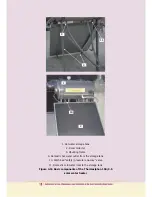
1.6 Clothes washing
Hot water from a solar domestic water heater can be used in a washing machine
in the case that it (the washing machine) has
two feeding pipes
, one for hot
water and one for cold water. Such washing machines exist and their cost is not
higher than the cost of a washing machine with one feeding pipe (cold water). Their
washing cycle is faster, because it does not require time for water heating.
The use of washing machines with two feeding pipes (hot water, cold water) can
increase the energy delivery from a solar domestic system. The faster washing
cycle is an additional benefit.
Attention should be given to the maximum water temperature that is allowed by
the manufacturer of the washing machine and considering the fact that the solar
water heater may develop high temperatures under certain conditions.
1.7 Dishwashing with solar hot water
Hot water from a solar domestic system
can not
be used directly in a dishwasher.
The reason is that the manufacturer of the dishwasher specifies a maximum
temperature for the feeding water, usually of the order of 60
o
C. A domestic solar
system can develop, during summer, water temperature higher than 60
o
C (it can be
up to 95
o
C) under some conditions (limited use of the hot water).
A
mixing valve
(to mix in some cold water, see Figure 4.14) installed at the hot
water outlet of the domestic solar system can control the hot water temperature
so that it does not exceed 60oC. Under these conditions, hot water from the solar
system can be used in a dishwasher. At the same time the user of hot water is
protected from water temperatures higher than 60
o
C, which may cause burns to
skin.
Mixing devices are used in many hot water applications in large installations, but
they are rather expensive. Low cost, simple mixing devices exist that can be used
in a domestic solar system. Their cost is lower than 50 Euro.
Please contact the authorised Service of SUN&HEAT for the installation of such a
mixing valve.
1.8 Efficient use of a solar domestic hot water system
A solar collector is required to absorb solar irradiance and to transfer the absorbed
energy into a heat transfer fluid with a minimum of heat losses.
The thermal efficiency of a solar collector is high when its operating temperature is
low. In contrast, its efficiency is low when the operating temperature is high. In the











































